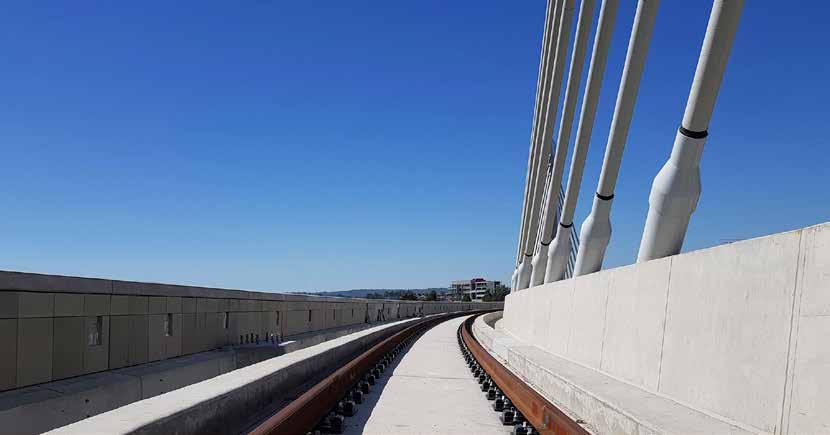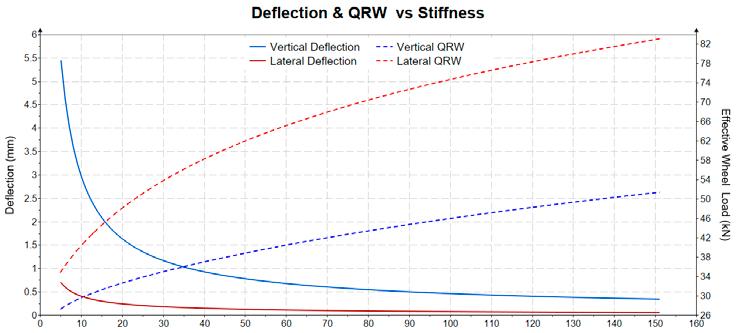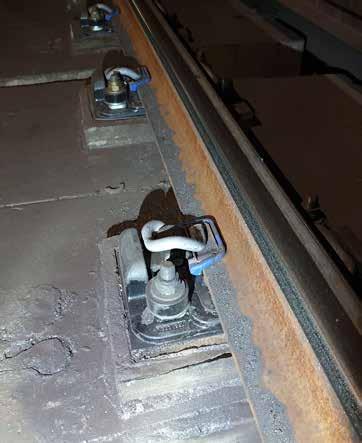
6 minute read
Track Fastening Systems
Reinforcing Railway Infrastructure with Bonded Resilient Fastening Systems
By Liam Turbet
Advertisement
Technical Manager, Delkor Rail Pty Ltd
Resilient rail fastening systems have been in common use around the world for many years now, with the first bonded systems becoming available in the 1970s.
Prior to bonded rail fastening systems becoming available, the typical method for increasing the resilience of rail fastening systems was to introduce an elastomeric pad, either between the baseplate and supporting structure, or between the rail foot and the rail seat of the fastening system. While these types of systems provide some vertical resilience and decrease in vertical track stiffness, the lateral resilience and load distributing characteristics of these systems remained essentially unchanged. Lateral wheel loads in these systems are typically either transferred directly to the anchor bolts of the system, in the case of an elastomeric pad beneath a baseplate, or result in very high rail clip deflections and stresses in the case of an elastomeric rail seat pad. This approach has its merits for use in ballasted track, where lateral resilience is provided by the ballast/sleeper interaction, but in concrete slab track construction, bridge transom structures, or elevated viaduct structures, the lack of lateral resilience results in increased component stresses and in some cases premature failure.
To understand why lateral resilience matters in non-ballasted track systems, it is essential to understand the relationship between the rail moment of inertia and the fastening system stiffness in both vertical and lateral senses.
The rail moment of inertia is a key parameter that determines how much the rail will bend. A very high moment of inertia results in less bending, where the highest load along the rail is located. Less bending, i.e. higher stiffness rails, apply pressure more evenly to the rail seats supporting them over a longer length. This fact has been the reason for rails increasing in weight over time as rolling stock has become heavier and faster, leading to higher axle loads and productivity. This key parameter is dictated by the shape of the rail, with a taller rail having a higher vertical stiffness. The lateral stiffness or moment of inertia of the rail is also dictated by its shape, however in nearly all cases the lateral stiffness of a rail is significantly less than its vertical stiffness. As an example, the difference between lateral and vertical moment of inertia is approximately 6 fold! Consequently, lateral wheel loads tend to be more concentrated at rail seats and fastening systems, as the rail has less resistance to bending laterally than vertically.
This is where the stiffness of the fastening system becomes important. The vertical stiffness of the fastening system helps to distribute the vertical component of the wheel load across a larger number of rail seats. The lower the stiffness of the fastening system, the further the load is distributed thanks to the rails ability to resist vertical bending. However, in traditional, non-bonded fastening systems there is typically a very high lateral stiffness. This very high stiffness lateral support coupled with the lower resistance to lateral bending in the rail amplifies the load and stress that these fastening systems experience from the lateral component of the wheel load. This effect becomes more pronounced in curves where the lateral wheel load increases relative to the vertical wheel load. Visual signs of these load concentrations include cracking of concrete around fastening system anchors, frequently breaking rail clips, failed anchor bolts, increased abrasive wear on rail seat components and increased rates of rolling contact fatigue.
So how do bonded fastening systems address this issue?
Bonded fastening systems such as the Delkor Egg and ALT-1 are comprised of a top plate, that is fastened to the rail foot and a base frame or plate that is anchored to the supporting structure. These two pieces are then bonded together to form a single piece using a natural rubber compound through a vulcanisation process. It is this bonded natural rubber compound that becomes the resilient element of the fastening system. The resilient element surrounds the top plate and provides a lower stiffness, not only vertically, but also laterally. The decreased lateral stiffness allows for a small amount of lateral deflection at the rail seat, which can significantly reduce the lateral loading that each fastening system experiences. Since the top plate, clipped to the rail, can move relative to the bottom frame in all directions there are significantly reduced stresses in rail clips. In these systems the rail is not required to move in the rail seat as with a resilient rail seat pad. This in turn also leads to reduced abrasive wear in rail seat components. Bonded fastening systems have fewer individual

Deflection vs QRW vs Stiffness
parts that move against each other, meaning less abrasive wear. As a result these systems can achieve long service lives with little to no maintenance requirement.
Modelling of the effective wheel load (QRW), the load that each fastening system experiences, and deflection for a given rail section and rolling stock both laterally and vertically shows the benefits of introducing lower lateral stiffness in non-ballasted track systems. The graph above shows this modelling for a curve and it can be seen that by selecting fastening systems with lower lateral stiffness i.e. 10-20kN/mm compared with 150kN/mm can lead to a reduction in lateral effective wheel load of 40-50%. In practice this results in lower stress for components within the system and in the supporting structure.
These reinforcing benefits are not exclusive to greenfield projects. Bonded fastening systems such as the ALT-1 can be designed and manufactured as drop-in replacements for existing systems that use resilient rail seat pads or base pads.
The Toronto Experience
A particular section of Toronto’s Transit system has a curved section of track that required quite frequent maintenance. The rail clips in this curve were failing at very high rates, so high in fact that rail clips were stored on site, in the tunnel, so that maintenance crews would have them at hand for replacement without needing to bring them in. Additionally anchor studs would often fail and need to be cored out and replaced. The fastening system used in this area included a resilient rail seat pad, which, due to the high lateral wheel loads in this curve, was causing large deflections in the rail clips as the rail moved within the rail seat resulting in early clip failures. Delkor Rail was able to develop an ALT-1 design that matched the existing anchoring system pattern, rail seat height and inclination so that it could be installed without modifying the track alignment or performing any major structural work. The ALT-1 introduced lateral resilience to this area of the track with very significant benefits. Since the installation was carried out, there have been no reports of clip failures, resulting in a significant reduction in maintenance hours.
Higher strength material isn’t always the answer
diameters in an effort to resist the, at times, immense loads imparted by the passage of rolling stock. It seems counter intuitive that the answer may often be the opposite. Allowing the rail track a small degree of movement using resilient fastening systems can unlock huge benefits for the system as a whole. The increased
distribution of loading is just one benefit of bonded resilient fastening systems. Reduction in ground borne vibration as a result of the lower natural frequency of these systems has usually been the driving factor for their adoption, but even if this is not your prime concern these systems can reinforce your track and help spread the load.

Delkor ALT-1 Toronto Retrofit






